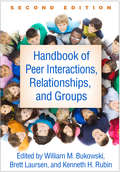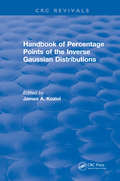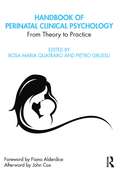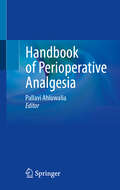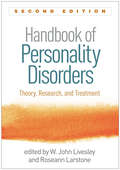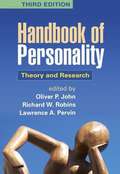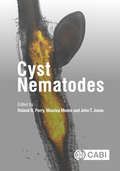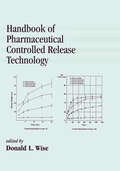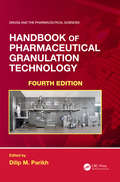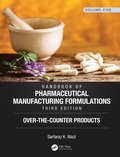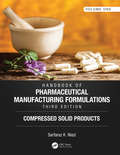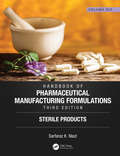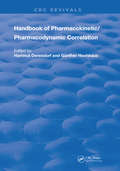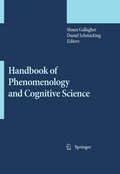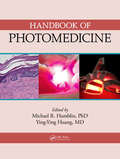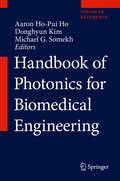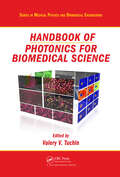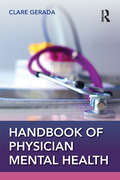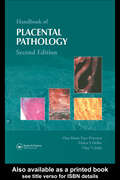- Table View
- List View
Handbook of Peer Interactions, Relationships, and Groups, Second Edition
by William M. Bukowski Brett Laursen Kenneth H. RubinThe definitive handbook on peer relations has now been significantly revised with 55% new material. Bringing together leading authorities, this volume presents cutting-edge research on the dynamics of peer interactions, their impact on multiple aspects of social development, and the causes and consequences of peer difficulties. From friendships and romance to social withdrawal, aggression, and victimization, all aspects of children's and adolescents' relationships are explored. The book examines how individual characteristics interact with family, group, and contextual factors across development to shape social behavior. The importance of peer relationships to emotional competence, psychological well-being, and achievement is analyzed, and peer-based interventions for those who are struggling are reviewed. Each chapter includes an introductory overview and addresses theoretical considerations, measures and methods, research findings and their implications, and future directions. New to This Edition *Chapters on topics largely new to the field: neuroscience, social media, social inequality, prosocial behavior with peers, and sociological approaches. *Expanded coverage of applied issues: chapters on interventions for socially withdrawn children, activity programs that promote positive youth development, and policy initiatives. *Chapters on same- and other-sex peer relationships, peer influence, educational environments, evolutionary models, the self-concept, personality, and animal studies. *Increased attention to variations in peer relations due to culture, gender, and race. *Many new authors and topics reflect a decade's worth of theoretical and methodological advances, including the growing use of complex longitudinal methods.
Handbook of Percentage Points of the Inverse Gaussian Distributions
by James A. KoziolThe purpose of this handbook is to provide comprehensive tables of percentage points of the inverse Gaussian distribution. There is no other publication available today which condenses these tables - to such extent-in a concise, straightforward manner. The inverse Gaussian distribution is not only important for determining boundary crossing probabilities of Brownian Motion, which probabilities determine the operating characteristics of many sequential sampling procedures in statistics. It is also used in quality control procedures. This one-of-a-kind work includes a brief introductory section which outlines the inverse Gaussian distribution and explains the tables. The tables are produced in a fine grid of cumulative probabilities, and uses the closed form expression for the cumulative distribution function. This easy-to-use table reference also includes an excellent discussion of searching ordered tables. This handbook is a helpful, indispensable guide for all who are involved with statistics, mathematics, and computers. Mechanical engineers and physicists will find it useful also.
Handbook of Perinatal Clinical Psychology: From Theory to Practice
by Rosa Maria Quatraro Pietro GrussuThe book examines the major issues in perinatal clinical psychology with the presence of theoretical information and operational indications, through a biopsychosocial approach. The multiplicity of scientific information reported makes this book both a comprehensive overview on the major perinatal mental health disorders and illnesses, and a clinical guide. It covers perinatal clinical psychology through a journey of 15 chapters, putting the arguments on a solid theoretical basis and reporting multiple operational indications of great utility for daily clinical practice. It has well documented new evidence bases in the field of clinical psychology that have underpinned the conspicuous current global and national developments in perinatal mental health. As such, it is an excellent resource for researchers, policy makers, and practitioners – in fact, anyone and everyone who wishes to understand and rediscover, in a single opera, the current scientific and application scenario related to psychological health during pregnancy and after childbirth.
Handbook of Perioperative Analgesia
by Pallavi AhluwaliaThe book is a guide to perioperative analgesia, designed to equip healthcare professionals with the latest strategies to manage perioperative pain effectively. It offers a blend of theoretical knowledge and practical applications, making it an indispensable tool for practitioners aiming to enhance patient outcomes and recovery during the perioperative period. The chapters cover a wide range of topics, including pain assessment, pain pathways, and preventive analgesia. It includes expert insights into advanced analgesic methods for various surgical procedures, as well as tailored pain management solutions for diverse patient populations. The book also addresses the challenges of managing opioid-dependent patients and provides evidence-based solutions for acute pain management services. The chapters highlight the genetic polymorphisms involved in pain mechanisms and the unique considerations required for pediatric patients. The book is targeted at anesthesiologists, surgeons, pain management specialists, and healthcare professionals involved in perioperative care. It bridges the gap between current practices and cutting-edge advancements. It is also suitable for postgraduate students and practicing pain physicians, meeting curriculum and examination requirements for courses in anesthesiology and pain medicine.
Handbook of Peripheral Neuropathy (Neurological Disease and Therapy)
by Mark B. Bromberg A. Gordon SmithProviding a detailed study of the anatomy, physiology, and pathology of peripheral nerves, this reference provides a clear approach to the evaluation, characterization, and treatment of peripheral neuropathies-reviewing each major class of these disorders with authoritative discussions of clinical characteristics, electrodiagnostic features, examin
Handbook of Personality Disorders, Second Edition: Theory, Research, and Treatment
by W. John Livesley Roseann LarstoneThe leading reference on personality disorders and their treatment, this authoritative work is now significantly revised with 80% new content reflecting important advances in the field. Preeminent experts provide in-depth coverage of conceptual and taxonomic issues, psychopathology, epidemiology and longitudinal course, etiology and development, and specific diagnoses. Diagnostic issues are explored and available assessment instruments discussed. All available evidence-based treatments are reviewed in consistently organized chapters that cover theoretical and empirical foundations as well as clinical strategies, facilitating comparison of the various approaches. New to This Edition *Incorporates more than 15 years of major research advances; includes 21 chapters on new topics. *Critically examines DSM-5 diagnostic criteria. *Chapters on additional treatments--mentalization-based treatment, schema-focused therapy, transference-based psychotherapy, and systems training for emotional predictability and problem solving. *Chapters on cutting-edge topics such as dimensional models, longitudinal studies, and personality pathology in children and adolescents. *Chapters on specific diagnoses: antisocial/psychopathic, borderline, and obsessive–compulsive personality disorder. *Integrative section introductions by the editors. See also Integrated Treatment for Personality Disorder, edited by W. John Livesley, Giancarlo Dimaggio, and John F. Clarkin, which weaves multiple well-established intervention strategies into a systematic modular approach.
Handbook of Personality, Fourth Edition: Theory and Research
by Oliver P. John Richard W. RobinsNow in a revised and expanded fourth edition, this definitive reference and text has more than 50% new material, reflecting a decade of theoretical and empirical advances. Prominent researchers describe major theories and review cutting-edge findings. The volume explores how personality emerges from and interacts with biological, developmental, cognitive, affective, and social processes, and the implications for well-being and health. Innovative research programs and methods are presented throughout. The concluding section showcases emerging issues and new directions in the field. New to This Edition *Expanded coverage of personality development, with chapters on the overall life course, middle childhood, adolescence, and early adulthood. *Three new chapters on affective processes, plus chapters on neurobiology, achievement motivation, cognitive approaches, narcissism, and other new topics. *Section on cutting-edge issues: personality interventions, personality manifestations in everyday life, geographical variation in personality, self-knowledge, and the links between personality and economics. *Added breadth and accessibility--42 more concise chapters, compared to 32 in the prior edition.
Handbook of Personality, Third Edition
by Richard Robins Oliver JohnThis authoritative handbook is the reference of choice for researchers and students of personality. Leading authorities describe the most important theoretical approaches in personality and review the state of the science in five broad content areas biological bases; development; self and social processes; cognitive and motivational processes; and emotion, adjustment, and health. Within each area, chapters present innovative ideas, findings, research designs, and measurement approaches. Areas of integration and consensus are discussed, as are key questions and controversies still facing the field.
Handbook of Pest Management in Organic Farming
by Capacity Building for Sustainable Development Valentine JamesThis book is a compendium of current information on all aspects of these economically important parasites. It provides comprehensive coverage of their biology, management, morphology and diagnostics, in addition to up-to-date information on molecular aspects of taxonomy, host-parasitic relationships and resistance. Written by a team of international experts, Cyst Nematodes will be invaluable to all researchers, lecturers and students in nematology, parasitology, agriculture and agronomy, industries with an interest in chemical and biological control products for management of plant-parasitic nematodes, and any courses, quarantine and advisory services.
Handbook of Pharmaceutical Controlled Release Technology
by Donald L. WiseThe Handbook of Pharmaceutical Controlled Release Technology reviews the design, fabrication, methodology, administration, and classifications of various drug delivery systems, including matrices, and membrane controlled reservoir, bioerodible, and pendant chain systems.Contains cutting-edge research on the controlled delivery of biomolecules!
Handbook of Pharmaceutical Granulation Technology (Drugs and the Pharmaceutical Sciences #4)
by Dilip M. ParikhThis fully revised edition of Handbook of Pharmaceutical Granulation Technology covers the rapid advances in the science of agglomeration, process control, process modelling, scale-up, emerging particle engineering technologies, along with current regulatory changes presented by some of the prominent scientist and subject matter experts around the globe. Learn from more than 50 global subject matter experts who share their years of experience in areas ranging from drug delivery and pharmaceutical technology to advances in nanotechnology. Every pharmaceutical scientist should own a copy of this fourth edition resource. Key Features: Theoretical discussions covering granulation and engineering perspectives. Covers new advances in expert systems, process modelling and bioavailability Chapters on emerging technologies in particle engineering Updated Current research and developments in granulation technologies
Handbook of Pharmaceutical Manufacturing Formulations, Third Edition: Volume Five, Over-the-Counter Products
by Sarfaraz K. NiaziThe Handbook of Pharmaceutical Manufacturing Formulations, Third Edition: Volume Five, Over-the-Counter Products is an authoritative and practical guide to the art and science of formulating drugs for commercial manufacturing. With thoroughly revised and expanded content, this fifth volume of a six-volume set, compiles data from FDA and EMA new drug applications, patents and patent applications, and other sources of generic and proprietary formulations including author’s own experience, to cover the broad spectrum of cGMP formulations and issues in using these formulations in a commercial setting. A must-have collection for pharmaceutical manufacturers, educational institutions, and regulatory authorities, this is an excellent platform for drug companies to benchmark their products and for generic companies to formulate drugs coming off patent. Features: Largest source of authoritative and practical formulations, cGMP compliance guidance and self-audit suggestions Differs from other publications on formulation science in that it focuses on readily scalable commercial formulations that can be adopted for cGMP manufacturing Tackles common difficulties in formulating drugs and presents details on stability testing, bioequivalence testing, and full compliance with drug product safety elements Written by a well-recognized authority on drug and dosage form development including biological drugs and alternative medicines
Handbook of Pharmaceutical Manufacturing Formulations, Third Edition: Volume Four, Semisolid Products
by Sarfaraz K. NiaziThe Handbook of Pharmaceutical Manufacturing Formulations, Third Edition: Volume Four, Semisolid Products is an authoritative and practical guide to the art and science of formulating drugs for commercial manufacturing. With thoroughly revised and expanded content, this fourth volume of a six-volume set, compiles data from FDA and EMA new drug applications, patents and patent applications, and other sources of generic and proprietary formulations including author’s own experience, to cover the broad spectrum of cGMP formulations and issues in using these formulations in a commercial setting. A must-have collection for pharmaceutical manufacturers, educational institutions, and regulatory authorities, this is an excellent platform for drug companies to benchmark their products and for generic companies to formulate drugs coming off patent. Features: Largest source of authoritative and practical formulations, cGMP compliance guidance and self-audit suggestions Differs from other publications on formulation science in that it focuses on readily scalable commercial formulations that can be adopted for cGMP manufacturing Tackles common difficulties in formulating drugs and presents details on stability testing, bioequivalence testing, and full compliance with drug product safety elements Written by a well-recognized authority on drug and dosage form development including biological drugs and alternative medicines
Handbook of Pharmaceutical Manufacturing Formulations, Third Edition: Volume One, Compressed Solid Products
by Sarfaraz K. NiaziThe Handbook of Pharmaceutical Manufacturing Formulations, Third Edition: Volume One, Compressed Solid Products is an authoritative and practical guide to the art and science of formulating drugs for commercial manufacturing. With thoroughly revised and expanded content, this first volume of a six-volume set, compiles data from FDA new drug applications, patent applications, and other sources of generic and proprietary formulations to cover the broad spectrum of GMP formulations and issues in using these formulations in a commercial setting. A must-have collection for pharmaceutical manufacturers, educational institutions, and regulatory authorities, this is an excellent platform for drug companies to benchmark their products and for generic companies to formulate drugs coming off patent.
Handbook of Pharmaceutical Manufacturing Formulations, Third Edition: Volume Six, Sterile Products
by Sarfaraz K. NiaziThe Handbook of Pharmaceutical Manufacturing Formulations, Third Edition: Volume Six, Sterile Products is an authoritative and practical guide to the art and science of formulating drugs for commercial manufacturing. With thoroughly revised and expanded content, this sixth volume of a six-volume set, compiles data from FDA and EMA new drug applications, patents and patent applications, and other sources of generic and proprietary formulations including author’s own experience, to cover the broad spectrum of cGMP formulations and issues in using these formulations in a commercial setting. A must-have collection for pharmaceutical manufacturers, educational institutions, and regulatory authorities, this is an excellent platform for drug companies to benchmark their products and for generic companies to formulate drugs coming off patent. Features: Largest source of authoritative and practical formulations, cGMP compliance guidance and self-audit suggestions Differs from other publications on formulation science in that it focuses on readily scalable commercial formulations that can be adopted for cGMP manufacturing Tackles common difficulties in formulating drugs and presents details on stability testing, bioequivalence testing, and full compliance with drug product safety elements Written by a well-recognized authority on drug and dosage form development including biological drugs and alternative medicines
Handbook of Pharmaceutical Manufacturing Formulations, Third Edition: Volume Three, Liquid Products
by Sarfaraz K. NiaziThe Handbook of Pharmaceutical Manufacturing Formulations, Third Edition: Volume Three, Liquid Products is an authoritative and practical guide to the art and science of formulating drugs for commercial manufacturing. With thoroughly revised and expanded content, this third volume of a six-volume set, compiles data from FDA and EMA new drug applications, patents and patent applications, and other sources of generic and proprietary formulations including author’s own experience, to cover the broad spectrum of cGMP formulations and issues in using these formulations in a commercial setting. A must-have collection for pharmaceutical manufacturers, educational institutions, and regulatory authorities, this is an excellent platform for drug companies to benchmark their products and for generic companies to formulate drugs coming off patent. Features: Largest source of authoritative and practical formulations, cGMP compliance guidance and self-audit suggestions Differs from other publications on formulation science in that it focuses on readily scalable commercial formulations that can be adopted for cGMP manufacturing Tackles common difficulties in formulating drugs and presents details on stability testing, bioequivalence testing, and full compliance with drug product safety elements Written by a well-recognized authority on drug and dosage form development including biological drugs and alternative medicines
Handbook of Pharmaceutical Manufacturing Formulations, Third Edition: Volume Two, Uncompressed Solid Products
by Sarfaraz K. NiaziThe Handbook of Pharmaceutical Manufacturing Formulations, Third Edition: Volume Two, Uncompressed Solid Products is an authoritative and practical guide to the art and science of formulating drugs for commercial manufacturing. With thoroughly revised and expanded content, this second volume of a six-volume set, compiles data from FDA and EMA new drug applications, patents and patent applications, and other sources of generic and proprietary formulations including author’s own experience, to cover the broad spectrum of cGMP formulations and issues in using these formulations in a commercial setting. A must-have collection for pharmaceutical manufacturers, educational institutions, and regulatory authorities, this is an excellent platform for drug companies to benchmark their products and for generic companies to formulate drugs coming off patent. Features: Largest source of authoritative and practical formulations, cGMP compliance guidance and self-audit suggestions Differs from other publications on formulation science in that it focuses on readily scalable commercial formulations that can be adopted for cGMP manufacturing Tackles common difficulties in formulating drugs and presents details on stability testing, bioequivalence testing, and full compliance with drug product safety elements Written by a well-recognized authority on drug and dosage form development including biological drugs and alternative medicines
Handbook of Pharmacokinetic/Pharmacodynamic Correlation (Routledge Revivals)
by Hartmut Derendorf Guenther HochhausFirst published in 1995: Combining the established disciplines of pharmacokinetics (PK), the relationship between drug concentration and time, and pharmacodynamics (PD), the relationship between drug effects and concentration, this handbook examines the relevant relationship between drug effects and time.
Handbook of Pharmacology and Physiology in Anesthetic Practice
by Robert K. Stoelting Simon C. HillierDesigned for quick reference in the operating room or rapid review for board exams, this handbook presents the most critical clinical information from the newly updated Fourth Edition of Pharmacology and Physiology in Anesthetic Practice.
Handbook of Phenomenology and Cognitive Science
by Shaun Gallagher Daniel SchmickingThe idea that phenomenology, in the European tradition, has something to offer the cognitive sciences is a recent development. Here, leading researchers address topics that lie at the intersection between phenomenological studies and the cognitive sciences.
Handbook of Photomedicine
by Michael R. Hamblin Ying-Ying HuangProviding the most comprehensive, up-to-date coverage of this exciting biomedical field, Handbook of Photomedicine gathers together a large team of international experts to give you a complete account of the application of light in healthcare and medical science. The book progresses logically from the history and fundamentals of photomedicine to di
Handbook of Photonics for Biomedical Engineering
by Donghyun Kim Aaron Ho-Pui Ho Michael G. SomekhNanophotonics has emerged rapidly into technological mainstream with the advent and maturity of nanotechnology available in photonics and enabled many new exciting applications in the area of biomedical science and engineering that were unimagined even a few years ago with conventional photonic engineering techniques. Handbook of Nanophotonics in Biomedical Engineering is intended to be a reliable resource to a wealth of information on nanophotonics that can inspire readers by detailing emerging and established possibilities of nanophotonics in biomedical science and engineering applications. This comprehensive reference presents not only the basics of nanophotonics but also explores recent experimental and clinical methods used in biomedical and bioengineering research. Each peer-reviewed chapter of this book discusses fundamental aspects and materials/fabrication issues of nanophotonics, as well as applications in interfaces, cell, tissue, animal studies, and clinical engineering. The organization provides quick access to current issues and trends of nanophotonic applications in biomedical engineering. All students and professionals in applied sciences, materials, biomedical engineering, and medical and healthcare industry will find this essential reference book highly useful.
Handbook of Photonics for Biomedical Science (Series in Medical Physics and Biomedical Engineering)
by Valery V. TuchinThe Handbook of Photonics for Biomedical Science analyzes achievements, new trends, and perspectives of photonics in its application to biomedicine. With contributions from world-renowned experts in the field, the handbook describes advanced biophotonics methods and techniques intensively developed in recent years.Addressing the latest problems in
Handbook of Physician Mental Health
by Clare GeradaThis definitive textbook on Practitioner Health mixes academic rigour with practitioner and patient experiences. The book covers all aspects of care relevant to any regulated health professional, focusing on the care of doctors and nurses with mental illness. The book builds on themes introduced in the award-winning publication Beneath the White Coat: Doctors, Their Minds and Mental Health from the same author. It provides an invaluable ‘how to manage’ companion to supplement and enhance the broader issues relating to doctors and mental illness addressed in that first book.Key Features Creates a thorough framework on how to assess a health professional with mental illness Includes evidence-based guidance on the diagnosis and management of common mental health problems in health professionals Supports an understanding of how the workplace affects mental health and how mental health affects work in the context of doctors working in a variety of settings Provides an understanding of the regulatory framework governing different health professionals Offers practical advice and guidance on primary prevention measures, including ‘how to spot doctors in distress’, ‘how to approach a doctor colleague to express concern’ and ‘how time and space can be developed within a department to address stress and burnout’ Drawing together 15 years of expertise in caring for more than 30,000 doctors with mental illness, the book is relevant to any health professional working in clinical practice and will be essential reading for those who regulate, appraise, train and support health practitioners across various disciplines.
Handbook of Placental Pathology
by Debra S. Heller Vijay V. Joshi Ona Marie Faye-PetersenA user-friendly text, this book explores all the diagnostic challenges pathologists and obstetricians will face. Succinct and accessible, the text includes discussions of lesions associated with maternal thrombophilias, updates in disorders with challenging clinicopathologic features and pathogenesis. The new edition contains updated sections on co
